|
Town To Countryside |
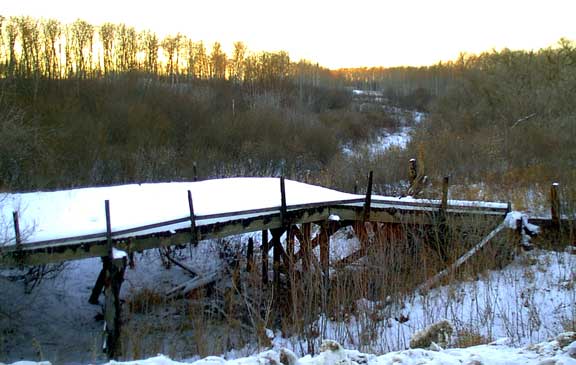 |
| FTLComm - Tisdale - January 27, 2001 |
| In this story I want to give you a sense of what Tisdale and its surrounding area
is like, I suppose more than anything I am aiming to give you something of the atmosphere,
the texture of life in this rural community. To begin, we start at the CN tracks which are four blocks from highway # 3 which is the South side of town, The sequence of pictures take you North up main street and into the country then we turn West and go a few miles then turn North and come back to highway # 35. Though most us who live here do not regard Tisdale as a small town, it really is, with the people and businesses located along this main street East and West from it for a few blocks, but there are few locations in the whole town where you can not look and see the surrounding countryside. |
 |
| The warm January weather this year is somewhat unsettling as this should on average be the coldest time of the year yet these pictures show Tisdale in late afternoon with the low angle of the Sun and the temperature somewhere above -10ºC. |
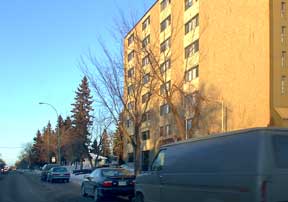 The sun catches the West side apartments in the McKay Tower senior citizens building, the tallest structure in town a mere eight stories tall. Senior citizens make up the majority of the towns people in this community as they have come here to retire, most from agriculture and surrounding communities. This is only one of many apartment buildings, with most of the senior citizens still living in single family dwellings or duplexes. The compactness of the community is one of the features that attracts people to Tisdale, as they can easily walk to any part of town in just a few minutes. For those who do not have cars and need transportation there is a taxi and a publicly operated transit vehicle designed to handle walking passengers and folks in wheel chairs. From here it is two blocks to walk to the post office or the Co-op mall and almost every other service the community has is within that distance. |
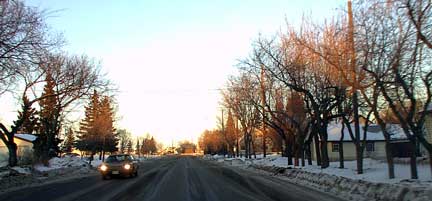 A couple of blocks further North the sun is just touching the tops of the trees and the sidewalks are covered with old snow as it has not only been abnormally warm this January it has also been almost entirely devoid of precipitation. On the North side of the town and also at a second site on the far West side, two huge factories are the town's largest employer, Northern Steel Industries. |
 |
| Northern Steel has been mentioned in Ensign many times and it is because this is one of the most important economic forces in the community, employing more than one hundred workers who build steel tanks and their accessories that are shipped to all parts of North America. From tall fuel storage tanks to complex automated fertilizer dispensing machines (seen below), Northern Steel is vitally important to this community giving it a bit of diversification. After all, this is an agrarian community and having heavy industry in the mix is a very good thing. |
 |
 The slogan for Tisdale is "The Land of Rape and Honey" as this is the centre of Canada's Canola production. Canola is a modern development of what was originally rapeseed but modified to produce high quality healthy vegetable oil. |
| The second part of the slogan relates to honey production. This picture taken less than a mile from the centre of the town is one of the many honey producing farms in the area. This one has a crew of busy workers who in the summer dash from field to field picking up the filled bee hives and setting out empty ones. |
 |
| This picture (above) is typical of this part of Saskatchewan, though the countryside is very flat there is a fair amount of bush. Volunteer natural poplar and some conifers identify this as "parkland" the zone that stretches diagonally across the province with the bald prairie to the South and the boreal forest to the North. |
 This picture is about three miles North of Tisdale and the long afternoon shadow reveal the contour of highway #35. As you can plainly see the highway is grooved both North and South bound lanes have the distinctive indentations, indicators of very heavy traffic. With the development of the many huge inland grain terminals in the area and the movement of almost all commodities by heavy "B" train semi-trail trucking units the highways are taking a tremendous pounding, more than they can endure and it is a matter that somehow politicians and the corporate world ignored. The railways which cris- cross this same country side handle only grain from the terminals to the ocean ports all other material movement flows on these overburdened roads, maintained by the public. |
| If you are concerned about this photographer driving along taking snap shots, they are taken with a fully automatic camera but do be concerned about this juggernaut coming toward you. Notice in the enlarged section upper right is a view of the cab with the driver on his cell phone. |
 |
 Saskatchewan's agriculture is always thought of as a grain growing business and that is an accurate description but the province is also home to a lot of small, medium and large cattle operations. In this picturesque portion of the Doghide valley is Dave Morgan's Wolf Creek farm with is herd of cattle. Farmers with cattle can take the low priced field production and feed it to their cattle and stay in business while the farmer solely dependent on grain production is at the mercy of the market place and the fixed, and growing costs of |
| production. |
 This red horse barn is in the yard of one of the many farms that has been absorbed into larger operations. The evergreen trees are part of the yard's shelter belt and the old barn was once a horse and cattle barn, a relic from another era in prairie agriculture. One of the major businesses in the Tisdale area is Walker Seeds. The Walker family were a farm family and got involved in trading specialty seed crops. Their sideline went from being a supplemental income to being one of the big businesses in the area. Buying peas and |
| lentils, canary seed, mustard, and special varieties of Canola, Walker Seeds buys production from throughout the entire |
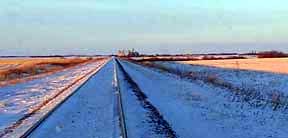 province
then sells that production to North American, province
then sells that production to North American, European and Asian markets. Their terminal and product handling plant is located North of Star City at a railway siding named Brooksby, close to the family farm. However, in the past five years the company's sales and trading has outstripped the Brooksby operation and a second facility has been set up at another old siding. The picture on the right shows this terminal as it is seen looking from the South. Walker Seeds not only buys and sells to its International customers these specialty crops but it also sells a wide variety of seeds to farmers, as well as providing special |
| pre-seeding processing to these seeds to assist in making them less susceptible to various antigens. |
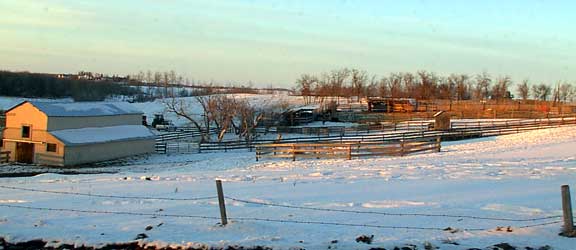 |
 This cattle operation is located in another valley West of the Walker Seed plant. The picture above is actually at feeding time as you can just make out a tractor emerging from behind the barn. It has a large device attached which spins around distributing and unbailing the huge round bails used to store the cattle's feed for the winter. This is a beef herd with both Hereford and Angus breeds seen in this picture. Cattle breeders have made effective use of artificial insemination so that the breeds of cattle we once considered the whole |
| universe of bovine life |
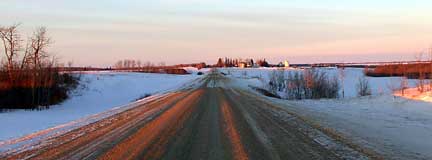 has
been radically altered has
been radically altered semintal cross with Herefords being by far the most popular form of beef cattle seen on farms today. Well, as we drive along we have turned North and this view shows a large grain farm yard in the distance. As you travel around Saskatchewan you can almost judge the productivity of the land and farmers by |
| viewing their yards. The |
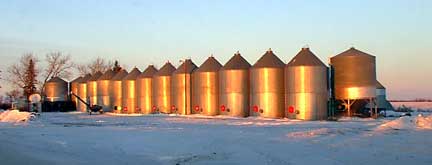 vast array of grain binds is vast array of grain binds isvery typical of large grain operations in this area where the yields tend to be consistently high, whereas in the South West and southern portion of the province in general, it would be rare to see this much onfarm storage because farms in that part of the province simply lack this level of productivity. This picture shows a grain handling vacuum parked |
| along side the bins, similar to the one shown earlier this week. |
 |
| The picture at the top of the page and above are just to the North of the farm site shown above. Once this old wooden bridge served the farm road in the area but now with the kind of heavy traffic these roads sustains such a bridge would no longer fill the bill. That set of grain bins in the picture above hides a shed behind it with a large tandem truck and a semi. |
 |
 The picture above shows another farm site perched atop the West side of this little valley that weaves through the countryside. Our travel has taken us around so that now we are looking at the Walker Seed terminal from the North West as you can see the long like of rail cars waiting to be loaded for shipment to market. Walker Seeds are not the only handler of the pulse type of crops, peas of various varieties and lentils but they are the major shipper in this area handling more than twice the volume of Harvest Valley Pool |
| terminal. |
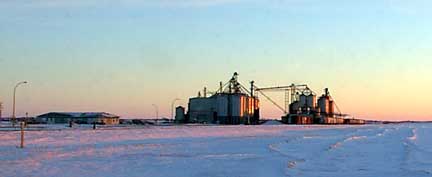 This form of terminal facility involves these large metal storage units and the metal work you see that strings to each are the conveyors, spouts and elevating gear that allows the operators to move the products around the facility from a computer controlled terminal centre. The product can be weighed, moved and put on rail cars all from the central control room. |
| This road descends toward highway #35 and a rather dangerous intersection. The highway traffic coming from the North and South is also descending hills from both directions so a large semi pulling out from the stop sign below can quickly be over taken by traffic from either direction who would not have much warning of the vehicle having pulled onto the highway and moving at a slow pace as it moves from the intersection up to highway speed. |
 |
| This little tour is a small sample of Tisdale and its economic roots, but these pictures tell you about the community, what it is and foreshadow what it will be in the future. |
|
Timothy W. Shire |